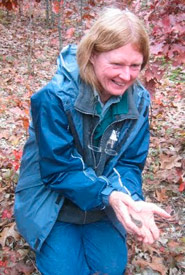Adventures restoring Lake Erie Farms
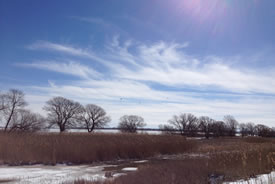
Norfolk, ON (Photo by NCC)
Not everything goes according to plan.
It was June 2009, the third growing season at the Nature Conservancy of Canada’s (NCC’s) Lake Erie Farms ecological restoration property in Norfolk County, Ontario. I was the ecological restoration expert on-site and I was puzzled that nothing was growing in the sunny areas. There were broad, brown stripes extending from east to west across the fields.
Worse still, as the days grew longer, the shaded areas shrank and the brown sections increased. A closer look revealed millions of little grasshoppers eating everything, including last year’s litter. Each day, little bluestem would grow an inch and then lose that inch as the grasshoppers nipped it down. This was only happening in the sunny areas because the grasshoppers could only warm up and feed when the sun hit the vegetation.
Suddenly, one day in early July they metamorphosed into small dark adults with wings and flew away to greener pastures.
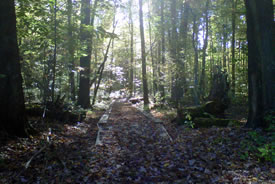
Norfolk County, ON (Photo by NCC)
At this point I met with NCC staff to discuss the brown fields. They were thinking grim thoughts. I explained the grasshopper theory and after some debate everyone shrugged and agreed this was a plausible explanation.
Restoration projects should exhibit resilience and this one certainly did. Within three weeks, all the plants had regrown and were flowering, and the little trees had leafed out again.
2016 marked the 11th growing season for the northern section and the 10th growing season for the central and southern sections of the Lake Erie Farms project. NCC purchased the 400-acre (160-hectare) property in December 2003. It acts as a significant corridor between South Walsingham Rolling Sand Ridges Area of Natural and Scientific Interest (ANSI) and the Venison Creek Valley ANSI.
The Lake Erie Farms property is part of NCC’s Norfolk Forests and Long Point Wetlands project, which aims to create an assemblage of private and public conservation lands in the heart of Carolinian Canada through securement and restoration.
The property was comprised of 184 acres (74 hectares) of agricultural fields and 216 acres (87 hectares) of forest upon purchase. Two years of biological inventory and planning went into the project. NCC staff and volunteers from the Long Point Basin Land Trust (LPBLT) worked together in the planning phase. Together, we identified biodiversity targets: bringing back the eastern hognose snake, whip-poor-will, grasshopper sparrow and antenna-waving wasp.
We constructed a successional trajectory of species occupancy for the restoration. For example, in the first year, grasshopper and vesper sparrows would arrive. At year five, we expected an abundance of indigo buntings and eastern towhees, by year 13, American redstarts and veeries, and so on. As it turned out, during the eighth year both veeries and grasshopper sparrows were using the middle of the largest field, each choosing their favourite bit of habitat. Now in the 10th year, buntings and towhees are still abundant.
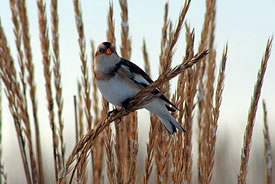
Snow bunting (Photo by Wikimedia Commons, John Haslam)
We visited nearby forest edges, openings and restorations to see what was working and what species could be seeded in our parcel. My partner, Peter Carson, and I had 14 years of experience with native plants to help us understand life history traits and which species would work well together.
Nevertheless, we knew that the science of ecological restoration is still young; building a natural ecosystem that is resilient, goes through successional changes fairly rapidly and supports biodiversity and ecological function could be a tall order. Luckily, native plants know what to do when given the chance.
We considered five types of restoration: controls where nothing was planted, sand barrens, oak savannah, oak woodlands and mesic forest. The areas were measured out and seeded using variations on a 100-species mix of trees, shrubs, wildflowers and grasses in the spring and fall of 2006. Two people on a mechanized plug planter seeded acorns, hazels, plums and hickory nuts on 132 acres (54 hectares).
After the nut planting, medium-sized fruit and wildflower seeds were thinly hand scattered. Then we used a Truax Wildflower Seeder with a sprocket packer to spread the hard and fluffy seeds of grasses and wildflowers.
The first growing season is perhaps the hardest to live with. Fields are full of giant, weedy annuals that hide the future restoration. However, this is short-lived. These weeds provide shade, a windbreak and water (from dew) to the emerging ecosystem. By the second growing season, weeds are just dead skeletons and the native plants begin to grow. By mid-July, the flower show is spectacular.
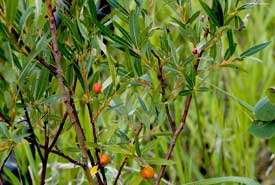
Willow gall (Photo by Gail F. Chin)
After the first five years, trees and shrubs begin to gain ground. American hazel and dwarf chinquapin oak produce lots of nuts. American plum and chokecherry flower and produce abundant fruit. The herbaceous layer becomes diverse as more conservative species mature and spread, such as wild lupine, New Jersey tea, butterfly weed and Virginia mountain mint.
This combination of trees and wildflowers supports many insects and birds. The oaks rank high as food for lepidoptera larvae that in turn feed most of the neotropical migratory birds and their young. Species play different roles in restoration. Ecological placeholders, such as the biennial evening primrose and wormwood, discourage serious biennial, exotic weeds, such as wild carrot and white sweet clover. Evening primrose may only dominate the site for a year or so, then disappear for a while until the site is disturbed by drought, fire or insect outbreaks.
Native nitrogen fixers, such as showy tick-trefoil and New Jersey tea, are important sources of nectar and seeds for insects and small mammals. Grasses, such as slender wheatgrass, become the matrix between other species, helping exclude non-natives, but giving way to tree seedlings. With complex seed mixes, species can choose optimal conditions and co-exist in their historic plant communities.
We set up three control plots where nothing was seeded, in order to compare natural regeneration in unseeded areas with intentionally seeded ones. These sites were rapidly colonized by Eurasian cool season grasses, quack grass and annual blue grass. Biennial weeds, such as hawk’s-beard, persisted as well. By July, non-native annuals had died back, leaving nothing to support native biodiversity.
It was surprisingly difficult for native wildflowers to seed into the control plots from the neighbouring seeded plots. Exotic plants colonized first and held their ground. In 2016, LPBLT and NCC worked together to eradicate exotic cool-season grasses and other invasives around edges and in the control plots of Lake Erie Farms.
Recently published research supports the idea that native herbaceous plants suppress weeds and facilitate establishment of tree cover.
As part of the restoration project, a densely-planted, one metre by one-metre mixed conifer hedge three rows wide was established to prevent invasion of exotics from road edges.
This has worked well. The deep shade, dense, year-round foliage and needle duff layer prevent most weeds from colonizing from a major road. Edges of forests can be a useful source of local plants. Planning exotic invasive control requires careful timing and a good understanding of plant life history traits. Many native species are frost-sensitive and do not appear until May, whereas the most damaging exotics tend to leaf out in April and can be treated with herbicides prior to green-up of the natives.
After 10 growing seasons, there is much to celebrate. Dry, sandy agricultural fields have been transformed into young oak savannah. Abundant wild lupines grace the open spaces in early June. Whip-poor-wills sing and countersing on moonlit nights. A very lucky eastern fox snake discovers a robin’s nest in a black oak sapling. A rare katydid sings on cool September nights from tussocks of little bluestem. These are the unexpected delights of ecological function.
The Lake Erie Farms project provides a great opportunity for education as well. Shortly after the land was purchased, students from the University of Toronto masters in forest conservation, Niagara College ecosystem restoration and other programs in Ontario’s colleges and universities have visited and learned about modern ecological restoration methods. Some have returned to carry out more research. Conservation groups and consultants come to experience the results of ecological restoration. The Norfolk Field Naturalists enjoy field trips to listen to the night sounds of coyotes, bats and whip-poor-wills, see expanses of wildflowers or marvel at the number of hazelnuts American hazels can produce.
At the International Union for the Conservation of Nature Congress in Hawaii this past September, German Parliamentary State Secretary Rita Schwarzeluhr-Sutter put it bluntly: “We need to launch a century of forest restoration and conservation.” Aldo Leopold, in his A Sand County Almanac (1949), encouraged us to, “save all the pieces.” The Lake Erie Farms restoration is a significant step in the right direction.
The post was written by Mary Gartshore and originally appeared in The Blazing Star, a publication of the North American Native Plant Society. Learn more at nanps.org.

